“Pichhwai of Sapta Swarupa Annakutotsava” has been added to your cart.
View cart
-
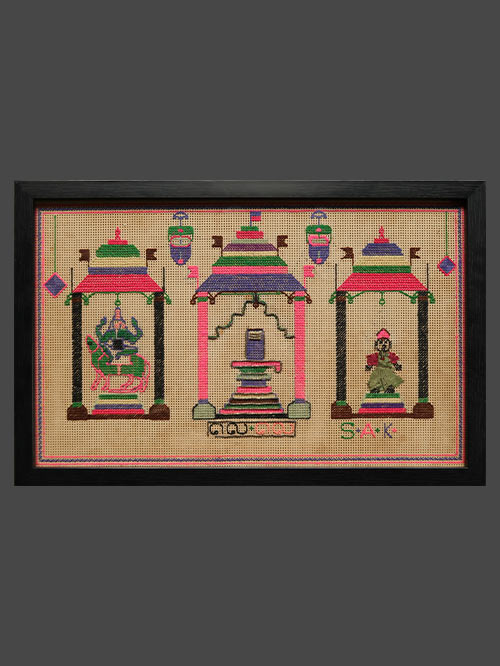
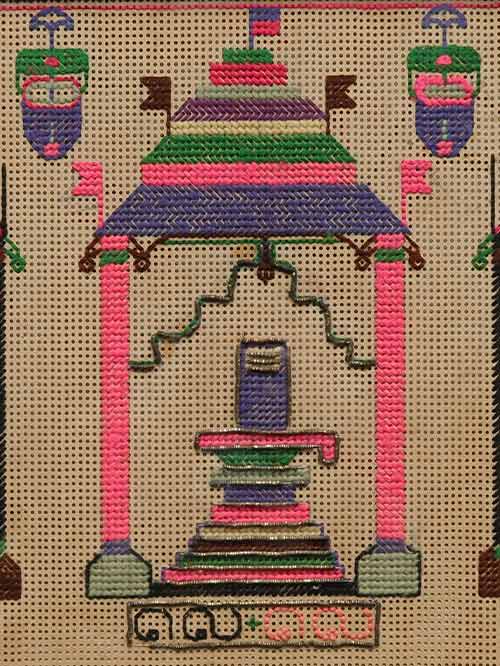
Chettinad (Tamil Nadu)
cross stitch embroidery
This decorative cross stitch embroidery artwork depicts three pillared niches, the central larger one with lingam flanked by two smaller ones with Ganesha and Kartikeya, temple lamps suspended above.
Framed Size (cms): 32(H) x 49(W)
Framed Size (inches): 12.5(H) x 19.5(W)
-
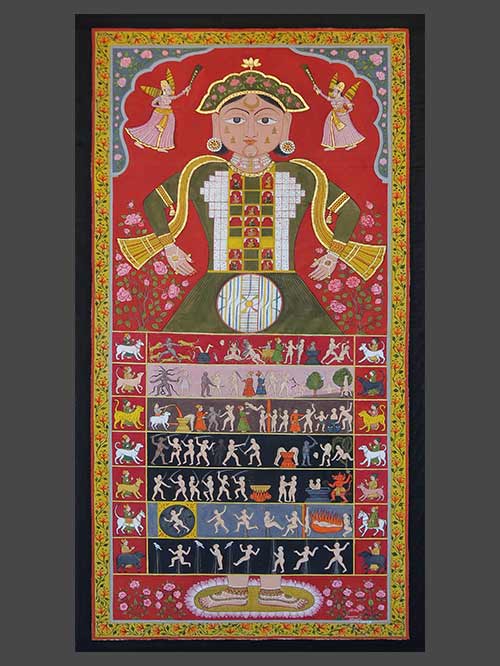
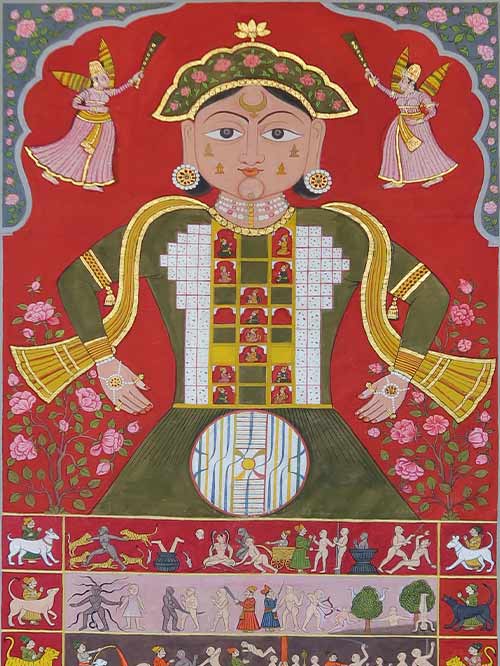
Rajasthan
Opaque watercolour on cloth with highlights in gold
Size (cms): 136(H) x 68(W)
Size (inches): 53.5(H) x 27(W)
-

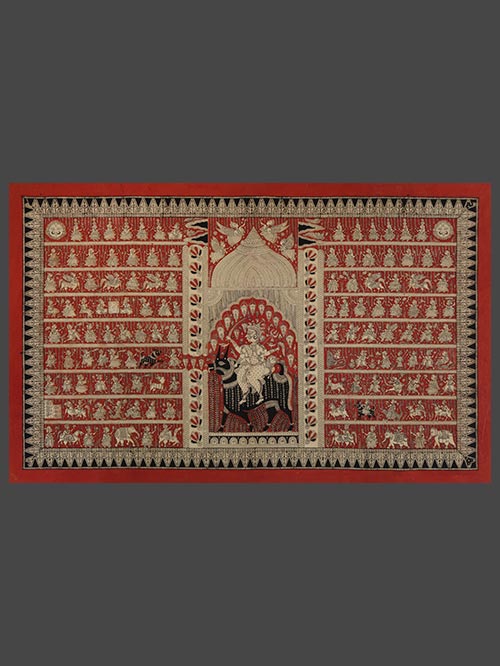
Gujarat
Mordants, painted and printed, and dyes on cotton cloth
The cloth features a prominent, centrally placed iconic image of Meladi Mata enshrined within a pavilion. A folk goddess worshiped by the Vaghri community of Gujarat, Meladi Mata is identified by her mount, the black goat. The four armed Goddess is sitting astride a goat carrying various weapons and implements. Around the central form on either side, are horizontal registers demarcated with lines. These registers are filled with rows of small hand-printed figures; some, portraying devotees, while others are singular images representing mythological characters or deities. On the left side in the middle register, a priest is depicted leading a buffalo to the central pavilion. On the right side, one row depicts various manifestations of the mother-goddess such as Ambika on a Tiger and Khodiar on a crocodile. Above them are depictions from the Hindu Epics, Mahabharata and Ramayana including Rama and Lakshman hunting the two-headed deer Maricha. The overall composition with its rows of devotees replicates the grand religious ceremony that would take place. The pictorial area of the composition is framed by geometric and floral bands.
In many regions of India, various types of imaged temple cloths, executed with different materials and techniques, have originated to serve narrative, iconic, or ritual ends for diverse groups of believers. One such tradition is found in Gujarat, where temple cloths painted and printed with mordants that combine with dyes to fix their colors are a component in goddess worship. The cloths, which were formerly made in villages in the areas surrounding Ahmedabad but now probably are produced only in the city proper, honour the Great Goddess under the aspect of Mother Goddess (Mata) one or more of several manifestations peculiar to Gujarat, such as Ambika on tiger, Bahuchara on a cock, Meladi on a billy goat, Khodiar on a crocodile, and Vihat on a water buffalo.
Size (cms): 99(H) x 159(W)
Size (inches): 39(H) x 62.5(W)
-
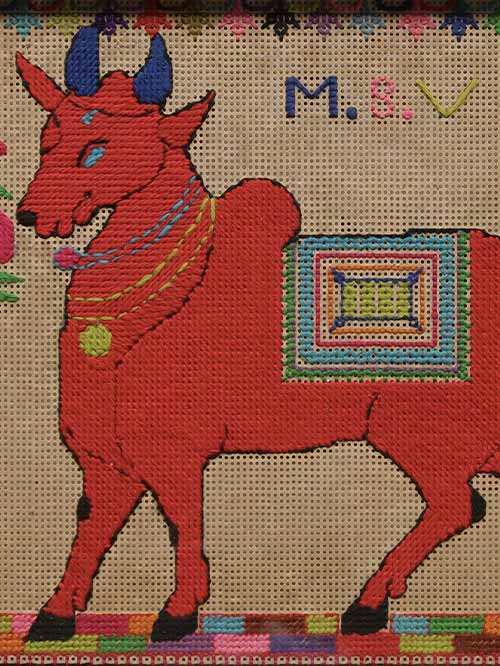
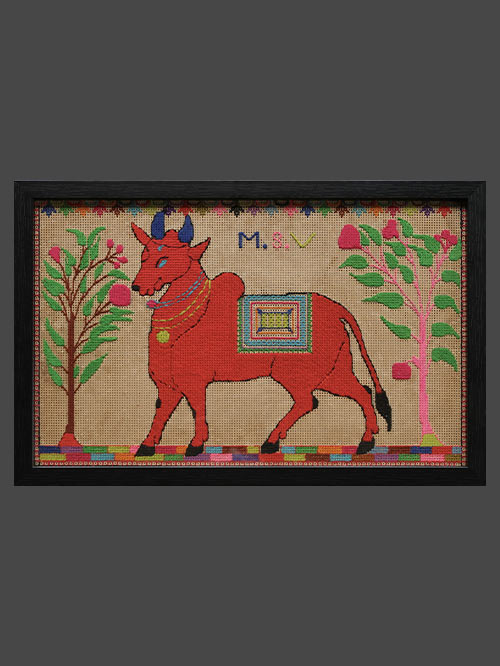
Chettinad (Tamil Nadu)
cross stitch embroidery
This whimsical cross stitch embroidery artwork depicts a bright orange caparisoned Nandi with blue horns stands facing left between two trees.
Framed Size (cms): 32(H) x 49(W)
Framed Size (inches): 12.5(H) x 19.5(W)
-
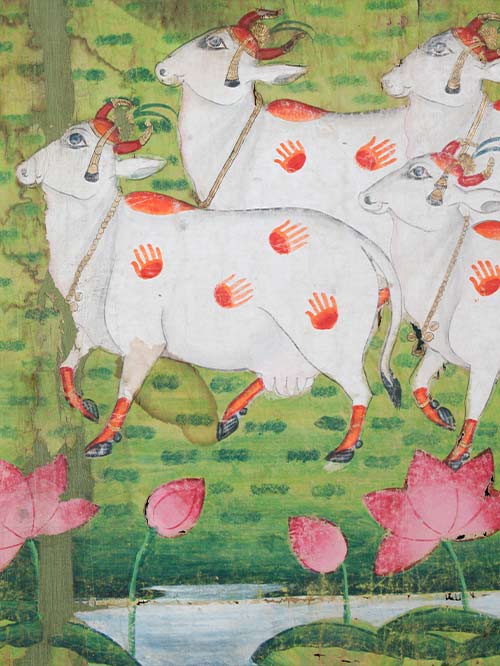
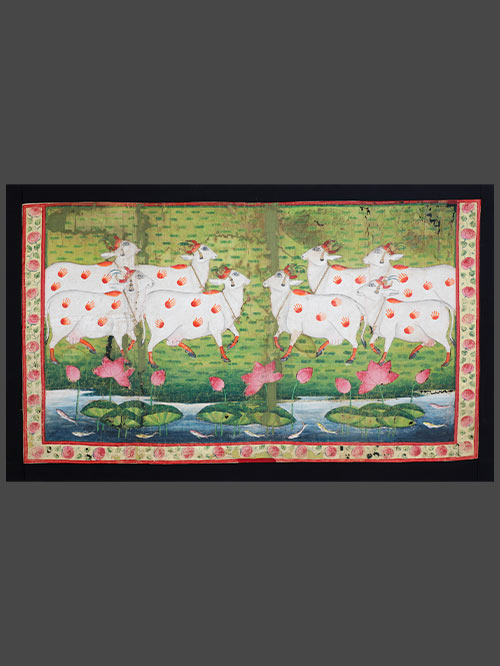
Nathdwara (Rajasthan)
Cotton, painted on pigments
An attractive small Pichhwai depicting eight white cows grouped in a meadow with a lotus and fish filled stream in the foreground. The cows are bedecked and have henna on their horns and hooves. Large handprints painted in saffron henna cover bodies. A floral border surrounds the panel. This pichhwai would have either accompanied a larger pichhwai in a prominent shrine or constituted part of a small domestic shrine.
Gopashtami is a festival that commemorates Krishna’s elevation from a young herder of calves to full cowherd. Krishna grows into the perfect cowherd, the one all the cows heed, answering to the golden strains of his flute. At Nathdwara the cows, decked in their finest, are brought into the haveli. There is a playful spirit about this festival that is well expressed in this pichhwai. The cows, gentle creatures with limpid eyes and expressive ears, are constant reminders of Vraja and Krishna’s childhood occupation as cowherd.
Size (cms): 75(H) x 124(W)
Size (inches): 29.5(H) x 49(W)
-
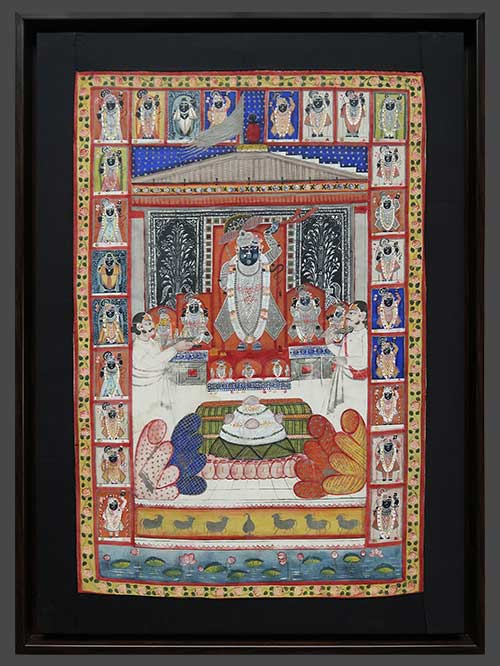

Nathdwara (Rajasthan)
Cotton, painted on pigments
A scarce small Pichhwai celebrating Sapta Swarupa Annakutotsava, with the central figure of Srinathji accompanied by his seven forms (Sapta Swarupa) and attended by two goswamis. Srinathji and the sath swarupa, are all richly adorned and bejewelled and they stand upon an elevated altar in front of a saffron covered thada vastra. A richly embroidered tree-of-life hanging encrusted with jewels and pearls is placed behind the shrine.
A veritable feast of chhappan bhoga (fifty-six offerings) in the form of large mounds of rice and curd, festooned with pink sweet meats are laid out in front of Srinathji. These offering commemorate the grand festival of Annakuta, the largest yearly festival celebrated at Nathdwara, which is held the day after Diwali. The festival is celebrated in recognition of an episode in the life of Krishna when he persuaded the villagers of Vraj to present their harvest offerings to the spirit of Mount Govardhana, instead of Indra. The mountains of rice symbolically represent Mount Govardhana which are topped by a sweet cake called gunja representing the head of Vishnu flanked by four more signifying the four ayudhyas or weapons of Vishnu.
The pichhwai is bordered by bands depicting Srinatji in twenty-four different Darshan attires on its sides and top and a row of nandis (cows) above a lotus filled lake below.
Size (cms): 81(H) x 59(W)
Size (inches): 32(H) x 23(W)













